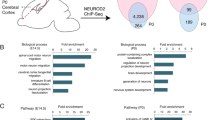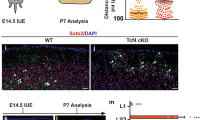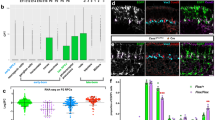Abstract
Motility is a universal property of newly generated neurons. How cell migration is coordinately regulated with other aspects of neuron production is not well understood. Here we show that the proneural protein neurogenin 2 (Neurog2), which controls neurogenesis in the embryonic cerebral cortex1,2, directly induces the expression of the small GTP-binding protein Rnd2 (ref. 3) in newly generated mouse cortical neurons before they initiate migration. Rnd2 silencing leads to a defect in radial migration of cortical neurons similar to that observed when the Neurog2 gene is deleted. Remarkably, restoring Rnd2 expression in Neurog2-mutant neurons is sufficient to rescue their ability to migrate. Our results identify Rnd2 as a novel essential regulator of neuronal migration in the cerebral cortex and demonstrate that Rnd2 is a major effector of Neurog2 function in the promotion of migration. Thus, a proneural protein controls the complex cellular behaviour of cell migration through a remarkably direct pathway involving the transcriptional activation of a small GTP-binding protein.
This is a preview of subscription content, access via your institution
Access options
Subscribe to this journal
Receive 51 print issues and online access
$199.00 per year
only $3.90 per issue
Buy this article
- Purchase on Springer Link
- Instant access to full article PDF
Prices may be subject to local taxes which are calculated during checkout




Similar content being viewed by others
References
Fode, C. et al. A role for neural determination genes in specifying the dorsoventral identity of telencephalic neurons. Genes Dev. 14, 67–80 (2000)
Schuurmans, C. et al. Sequential phases of neocortical fate specification involve Neurogenin-dependent and -independent pathways. EMBO J. 23, 2892–2902 (2004)
Chardin, P. Function and regulation of Rnd proteins. Nature Rev. Mol. Cell Biol. 7, 54–62 (2006)
Marin, O. & Rubenstein, J. L. Cell migration in the forebrain. Annu. Rev. Neurosci. 26, 441–483 (2003)
Ayala, R., Shu, T. & Tsai, L. H. Trekking across the brain: the journey of neuronal migration. Cell 128, 29–43 (2007)
McManus, M. F. & Golden, J. A. Neuronal migration in developmental disorders. J. Child Neurol. 20, 280–286 (2005)
Loturco, J. J. & Bai, J. The multipolar stage and disruptions in neuronal migration. Trends Neurosci. 29, 407–413 (2006)
Bertrand, N., Castro, D. S. & Guillemot, F. Proneural genes and the specification of neural cell types. Nature Rev. Neurosci. 3, 517–530 (2002)
Ross, S. E., Greenberg, M. E. & Stiles, C. D. Basic helix-loop-helix factors in cortical development. Neuron 39, 13–25 (2003)
Hand, R. et al. Phosphorylation of Neurogenin2 specifies the migration properties and the dendritic morphology of pyramidal neurons in the neocortex. Neuron 48, 45–62 (2005)
Ge, W. et al. Coupling of cell migration with neurogenesis by proneural bHLH factors. Proc. Natl Acad. Sci. USA 103, 1319–1324 (2006)
Nguyen, L. et al. p27kip1 independently promotes neuronal differentiation and migration in the cerebral cortex. Genes Dev. 20, 1511–1524 (2006)
Mattar, P. et al. A screen for downstream effectors of Neurogenin2 in the embryonic neocortex. Dev. Biol. 273, 373–389 (2004)
Gohlke, J. M. et al. Characterization of the proneural gene regulatory network during mouse telencephalon development. BMC Biol. 6, 15 (2008)
Nobes, C. D. et al. A new member of the Rho family, Rnd1, promotes disassembly of actin filament structures and loss of cell adhesion. J. Cell Biol. 141, 187–197 (1998)
Negishi, M. & Katoh, H. Rho family GTPases and dendrite plasticity. Neuroscientist 11, 187–191 (2005)
Nakamura, K. et al. In vivo function of Rnd2 in the development of neocortical pyramidal neurons. Neurosci. Res. 54, 149–153 (2006)
Tabata, H. & Nakajima, K. Multipolar migration: the third mode of radial neuronal migration in the developing cerebral cortex. J. Neurosci. 23, 9996–10001 (2003)
Huang, H. P. et al. Regulation of the pancreatic islet-specific gene BETA2 (neuroD) by neurogenin 3. Mol. Cell. Biol. 20, 3292–3307 (2000)
Yokota, Y., Ring, C., Cheung, R., Pevny, L. & Anton, E. S. Nap1-regulated neuronal cytoskeletal dynamics is essential for the final differentiation of neurons in cerebral cortex. Neuron 54, 429–445 (2007)
Englund, C. et al. Pax6, Tbr2, and Tbr1 are expressed sequentially by radial glia, intermediate progenitor cells, and postmitotic neurons in developing neocortex. J. Neurosci. 25, 247–251 (2005)
Seo, S., Lim, J. W., Yellajoshyula, D., Chang, L. W. & Kroll, K. L. Neurogenin and NeuroD direct transcriptional targets and their regulatory enhancers. EMBO J. (2007)
Castro, D. S. et al. Proneural bHLH and Brn proteins co-regulate a neurogenic programme through cooperative binding to a conserved DNA motif. Dev. Cell 11, 831–844 (2006)
Ince-Dunn, G. et al. Regulation of thalamocortical patterning and synaptic maturation by NeuroD2. Neuron 49, 683–695 (2006)
Schwab, M. H. et al. Neuronal basic helix-loop-helix proteins (NEX and BETA2/Neuro D) regulate terminal granule cell differentiation in the hippocampus. J. Neurosci. 20, 3714–3724 (2000)
Chardin, P. GTPase regulation: getting aRnd Rock and Rho inhibition. Curr. Biol. 13, R702–R704 (2003)
Kakimoto, T., Katoh, H. & Negishi, M. Identification of splicing variants of Rapostlin, a novel RND2 effector that interacts with neural Wiskott-Aldrich syndrome protein and induces neurite branching. J. Biol. Chem. 279, 14104–14110 (2004)
Tanaka, H., Katoh, H. & Negishi, M. Pragmin, a novel effector of Rnd2 GTPase, stimulates RhoA activity. J. Biol. Chem. 281, 10355–10364 (2006)
Goebbels, S. et al. Genetic targeting of principal neurons in neocortex and hippocampus of NEX-Cre mice. Genesis 44, 611–621 (2006)
Bron, R. et al. Boundary cap cells constrain spinal motor neuron somal migration at motor exit points by a semaphoring–plexin mechanism. Neural Dev. 2, 21 (2007)
Acknowledgements
We are grateful to S. Wood for technical assistance in generating transgenic embryos. We thank members of the Guillemot laboratory for suggestions on the manuscript, and F. Polleux (University of North Carolina) for the pNeuroD1 plasmid and D. Anderson (California Institute of Technology) for the anti-Neurog2 antibody. J.I.-T.H. is supported by an Australian CJ Martin Fellowship (grant number 310616) and a Medical Research Council career development fellowship (UK), L.N. and H.W. by postdoctoral fellowships awarded by the European Molecular Biology Organization, and D.S.C. and C.Z. by Medical Research Council career development fellowships (UK). This work was supported by grants from the European Commission 6th Framework Programme for Research and Technological Development to F.G. and by institutional funds from the Medical Research Council (UK).
Author Contributions J.I.-T.H. and F.G. conceived all experiments, analysed data and wrote the manuscript. Together with J.I-T.H., L.N. participated in ex vivo electroporation studies, H.W. conducted in utero electroporation experiments, C.Z. performed whole-embryo culture experiments, and D.S.C., D.S.-K. and J.-M.M. performed chromatin immunoprecipitation experiments. O.A. conducted the microarray screen, and F.B. and R.H. contributed to luciferase assays and immunostaining. All authors discussed results from experiments and commented on the manuscript.
Author information
Authors and Affiliations
Corresponding author
Supplementary information
Supplementary Information 1
This file contains Supplementary Figures 1 to 8 with Legends. (PDF 2881 kb)
Supplementary information 2
This file contains Supplementary Figures 9 to 16 for the manuscript. This file also contains Supplementary Table 1 which displays all statistics generated for the experiments herein, as well as legends to Supplementary Movies 1 to 7. (PDF 1240 kb)
Supplementary Movie 1
This file contains Supplementary Movie 1. This movie shows a control multipolar neuron undergoing migration within the intermediate zone. (AVI 2662 kb)
Supplementary Movie 2
This file contains Supplementary Movie 2. This movie shows an Rnd2siRNA-treated multipolar neuron undergoing migration within the intermediate zone. (AVI 3425 kb)
Supplementary Movie 3
This file contains Supplementary Movie 3. This movie shows a control uni/bipolar neuron undergoing migration within the cortical plate. (AVI 3143 kb)
Supplementary Movie 4
This file contains Supplementary Movie 4. This movie shows a Rnd2siRNA-treated uni/bipolar neuron undergoing migration within the cortical plate. (AVI 2756 kb)
Supplementary Movie 5
This file contains Supplementary Movie 5. This movie shows a neuron within the intermediate zone electroporated with the high-expression construct iZ/Rnd2. The neuron lacks neurite outgrowth and appear round. (AVI 2582 kb)
Supplementary Movie 6
This file contains Supplementary Movie 6. This movie shows neurons within the cortical plate electroporated with the high-expression construct iZ/Rnd2. The neuron exhibits a migration defect as well as stabilized leading processes. (AVI 3114 kb)
Supplementary Movie 7
This file contains Supplementary Movie 7. This movie shows neurons within the cortical plate electroporated with the low-expression construct pNeuroD1-Rnd2. The neuron exhibits a migration defect, as well as a stabilized leading processes and excess branching. (AVI 3679 kb)
Rights and permissions
About this article
Cite this article
Heng, JT., Nguyen, L., Castro, D. et al. Neurogenin 2 controls cortical neuron migration through regulation of Rnd2. Nature 455, 114–118 (2008). https://doi.org/10.1038/nature07198
Received:
Accepted:
Published:
Issue Date:
DOI: https://doi.org/10.1038/nature07198
This article is cited by
-
Molecular basis and current insights of atypical Rho small GTPase in cancer
Molecular Biology Reports (2024)
-
The Role of PLAG1 in Mouse Brain Development and Neurogenesis
Molecular Neurobiology (2024)
-
Epigenetic genes and epilepsy — emerging mechanisms and clinical applications
Nature Reviews Neurology (2022)
-
St18 specifies globus pallidus projection neuron identity in MGE lineage
Nature Communications (2022)
-
The atypical Rho GTPase Rnd2 is critical for dentate granule neuron development and anxiety-like behavior during adult but not neonatal neurogenesis
Molecular Psychiatry (2021)
Comments
By submitting a comment you agree to abide by our Terms and Community Guidelines. If you find something abusive or that does not comply with our terms or guidelines please flag it as inappropriate.



